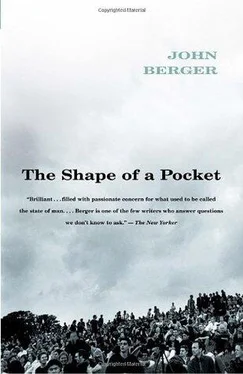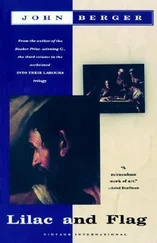Maybe when I say your ‘openness’, I’m simplifying and being too personal. Yes, it comes from you, but it passes into other things. In your painting of Pilar, the surface of pigment, those gestures one upon another like the household gestures of a mother during a life-time, the space of the room — all these are open to Pilar and her body waiting-to-be-seen. Or is it, rather, waiting-to-be-recognised?
In your landscapes the receptivity of the air to what it surrounds is even more evident. The sky opens to what is under it and in Christchurch Spitalfields, Morning 1990 , it bends down to surround it. In Christchurch Stormy Day, Summer 1994 , the church is equally open to the sky. The fact that you go on painting the same motif allows these collaborations to become closer and closer. Perhaps in painting this is what intimacy means? And you push it very far, in your own unmistakable way. For the sky to ‘receive’ a steeple or a column is not simple, but it’s something clear. (It’s what, during centuries, steeples and columns were made for.) And you succeed in making an early summer suburban landscape ‘receive’, be open to, a diesel engine!
And there I don’t know how you do it! I can only see that you’ve done it. The afternoon heat has something to do with it? But how does that heat become drawing? How does such heat draw in paint? It does, but I don’t know how. What I’m saying sounds complex. In fact all I’m saying is already there in your marvellous and very simple tide: Here Comes the Diesel.
You say that on the walls of your painting rooms there are some reproductions which have been pinned there for years. I wonder what? Last night I dreamt I saw at least one. But this morning I’ve forgotten it.
I suppose that soon you’ll be hanging the paintings at the Tate. I’ve never done it but I guess it’s a very hard moment. It’s difficult to hang paintings well because their therenesses compete. But apart from this difficulty, what I guess is hard is being forced to see them as exhibits. For Beuys it was OK because his collaboration was with the spectator. But for iconic works like yours it may seem, I imagine, like a dislocation, and therefore a violence. Yet don’t worry — they will hold their own. They are coming from their own place, like the train between Kilburn and Willesden Green.
With affection and respect
John
Dear John,
No one has written about the work of drawing and painting with such directness and selfless insight as you have in your last letter to me. That it’s ‘my’ work you are writing about is less important than the fact that, through your words, you acknowledge the separateness and independence of the images.
‘Thereness’ follows nothingness. It is impossible to premeditate. It is to do with the collaboration of the sitter, as you say, but also to do with the disappearance of the sitter the moment the image emerges. Is this what you mean by ‘the self-effacement of the good host’? The Fayum portraits of course emerge out of an attitude to life and death quite different from our own. In the pyramids there was life after death and the life was in the ‘thereness’ of the portraits. If there is something of this quality in the painting of Pilar it has more to do with the processes I am involved with than trying to paint a certain picture.
Pilar came to sit for me some years ago. She comes two mornings a week. For the first two or three years I drew from her. Then I started to paint her. Painting consists of working over the whole board quickly, trying to relate what was happening on the board to what I thought I was seeing. The paint is mixed before starting — there is always more than one board around to start another version. The process goes on a long time, sometimes a year or two. Though other things are happening in my life which affect me, the image that I might leave appears moments after scraping, as a response to a slight change of movement or light. Similarly with the landscape paintings. The subject is visited many times and lots of drawings are made, mostly very quickly. The work is begun in the studio where each new drawing means a new start until, one day, a drawing appears which opens up the subject in a new way, so I work from the drawing as I do from the sitter. It’s the process I am engaged in that is important.
I’m not too worried about the hanging of the paintings. The Tate are very good at this. The experience will be very strange. I haven’t seen many of the pictures for a very long time and as the event draws closer I become more aware that the work will represent an experiment in living which has been exciting, interesting and extending so I’m not so concerned about success or failure as I am about holding myself together to keep the experiment going. This is rather difficult.
The reproductions I have had on my wall since my student days are the Rembrandt Bathsheba , a late Michelangelo drawing, the Philadelphia Cezanne, Achille Empaire by Cezanne, and a photograph of some early works by Frank Auerbach. About 20 years ago I added a head by Velazquez (Aesop) and a portrait by Delacroix. I don’t look at them much but they are there.
Yours Leon
The portrait by Delacroix is of Apasie. I almost forgot the Judgement of Solomon by Poussin.
Dear Leon,
Yes, the disappearance of the sitter at a certain moment. And you’re right, I left that out. The image takes over. And in your case the image comes through all the vicissitudes of paint, board, plastering on, drawing, and scraping off: vicissitudes which produce something so movingly close to the wear and tear of life. So the image unpremeditatedly, as you say, takes over. And the slow process of discovering what is there without disturbing it, begins. Sometimes of destroying what’s there without disturbing it. (Eavesdroppers may consider us mad, but it’s true.) Then after all that, or during all that, isn’t there something else happening? The sitter — who may be a train, a church, a swimming pool — comes back through the canvas! It’s as if she disappears, vanishes, merges with everything else — takes a long journey on a kind of Inner Circle (which may last months or a year) and then re-emerges in the stuff with which all this time you’ve been struggling. Or am I again being too simple?
The ‘sitter’ is at first here and now. Then she disappears and (sometimes) comes back there, inseparable from every mark on the painting.
After she has ‘disappeared’ a drawing or two are the only clues about where she may have gone. And of course sometimes they’re not enough, and she never comes back …
Yes, at our age the most important thing is to ‘hold things together’ to ‘keep the experiment going’. And it’s (most of the time) rather difficult.
I guess the Bathsheba is the one where she’s holding a letter? And on her forearm she’s wearing a bracelet which, in a way I can’t understand but probably you can, is the keystone of the whole painting? And that marvellous rear leg in shadow, and everything tentative except her body.
My friend the Spanish painter, Barceló, has made a whole book of reliefs with a text in Braille to be felt with the fingers by those who are blind. And this makes me see that if a blind person felt Bathsheba’s body and then felt Pilar’s or Cathy’s, they would have the sensation of touching similar flesh. And this similarity is not to do with a similar way of painting but with a comparable respect for flesh, paint and their vicissitudes, their endless vicissitudes. The Aesop of Velazquez I too have lived with for years. A strange coincidence, Leon, no?
And again, at a level which has nothing to do with method, I see something in common between Aesop and your brother Chaim (1993). Something said by their presence. ‘He observes, watches, recognises, listens to what surrounds him and is exterior to him, and at the same time he ponders within, ceaselessly arranging what he has perceived, trying to find a sense which goes beyond the five senses with which he was born. The sense found in what he sees, however precarious and ambiguous it may be, is his only real possession.’
Читать дальше












